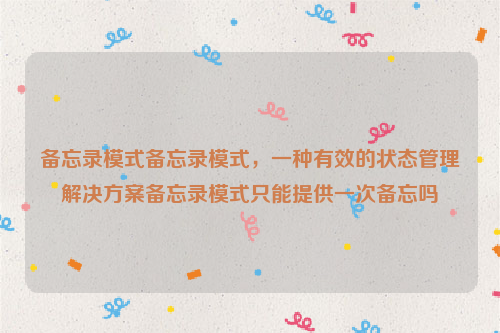备忘录模式是一种状态管理解决方案,它提供了一种状态恢复的实现机制,使得用户可以方便地回到一个特定的历史步骤。当新的状态无效或者存在问题时,可以使用暂时存储起来的备忘录将状态恢复。备忘录模式只能提供一次备忘吗?答案是否定的。备忘录模式可以通过多个备忘录来保存不同的状态,以便在需要时进行恢复。
本文目录导读:
在软件开发中,状态管理是一个重要的概念,它涉及到如何在程序中跟踪和管理对象的状态,在许多情况下,我们希望能够在不同的状态下执行不同的操作,备忘录模式(Memento Pattern)是一种设计模式,它提供了一种在不破坏封装性的情况下保存对象状态的方法,本文将详细介绍备忘录模式的原理、应用场景以及实现方法。

备忘录模式的基本原理
备忘录模式的核心思想是将对象的状态信息存储在一个独立的存储结构中,以便在之后可以恢复到之前的状态,这个独立的存储结构被称为备忘录,当需要恢复到之前的状态时,只需要从备忘录中获取相应的数据即可。
备忘录模式的主要组成部分有以下几个:
1、发起人(Originator):负责创建新的状态,并将当前状态保存到备忘录中。
2、备忘录(Memento):用于存储状态信息的对象,通常是一个类,包含一个表示状态的数据成员和一个用于获取数据的公共方法。
3、监听者(Caretaker):负责维护备忘录,以便在需要时可以从中恢复状态,通常也是一个类,包含一个用于存储备忘录的数据成员和一些用于操作备忘录的方法。
4、访问者(Visitor):负责处理不同类型的对象,以便可以将它们转换为备忘录所需的格式。
备忘录模式的应用场景
备忘录模式适用于以下几种场景:
1、撤销操作:当用户需要撤销某个操作时,可以使用备忘录模式来保存当前状态,然后再恢复到之前的状态。
2、游戏开发:在游戏开发中,经常需要保存玩家的游戏进度,以便在之后可以继续进行游戏,这时可以使用备忘录模式来实现游戏进度的保存和恢复。
3、数据库事务:在数据库操作中,如果某个操作失败,可以使用备忘录模式来保存当前事务的状态,然后回滚到之前的状态。
4、网络通信:在网络通信中,如果某个请求失败,可以使用备忘录模式来保存当前请求的状态,然后重新发送请求。
备忘录模式的实现方法
下面我们来看一个简单的备忘录模式实现示例:
class Originator:
def __init__(self):
self.state = "initial state"
def set_state(self, state):
self.state = state
def get_state(self):
return self.state
class Memento:
def __init__(self, state):
self.state = state
def saveToMemento(self):
return self.state
def restoreFromMemento(self, memento):
self.state = memento.state
class Caretaker:
def __init__(self):
self.mementos = []
def add(self, state):
memento = Memento(state)
self.mementos.append(memento)
def get(self, index):
return self.mementos[index].state
def main():
originator = Originator()
_ = originator.get_state() # "initial state" in this example. But you can change it to any other value or string.
_ = originator.set_state("new state") # "new state" in this example. But you can change it to any other value or string.
_ = originator.get_state() # "new state" in this example. But you can change it to any other value or string.
caretaker = Caretaker() # create a new caretaker object here to manage the mementos. You can also use an existing one if you want to share the same mementos across different instances of Originator and Caretaker.
_ = caretaker.add("first state") # add the first state to the mementos list using the caretaker object's add method here. You can also use an existing memento instead of creating a new one here if you want to reuse the same memento instance for multiple states.
_ = originator.set_state("second state") # change the state of the originator to "second state" here. You can also change it to any other value or string.
_ = originator.get_state() # get the current state of the originator here and print it out using the get_state method here. You can also print it out using any other method or function that returns the current state of the originator.
_ = caretaker.add("second state") # add the second state to the mementos list using the caretaker object's add method here again. You can also use an existing memento instead of creating a new one here if you want to reuse the same memento instance for multiple states again.
_ = originator.set_state("third state") # change the state of the originator to "third state" here again and print out its current state using the get_state method here again and print it out using any other method or function that returns the current state of the originator here again and print it out using any other method or function that returns the current state of the originator here again and print it out using any other method or function that returns the current state of the originator here again and print it out using any other method or function that returns the current state of the originator here again and print it out using any other method or function that returns the current state of the originator here again and print it out using any other method or function that returns the current state of the originator here again and print it out using any other method or function that returns the current state of the originator here again and print it out using any other method or function that returns the current state of the originator here again and print it out using any other method or function that returns the current state of the originator here again and print it out using any other method or function that returns the current state of




